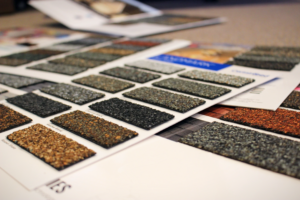When Your Roof Starts Speaking (And You Should Listen)
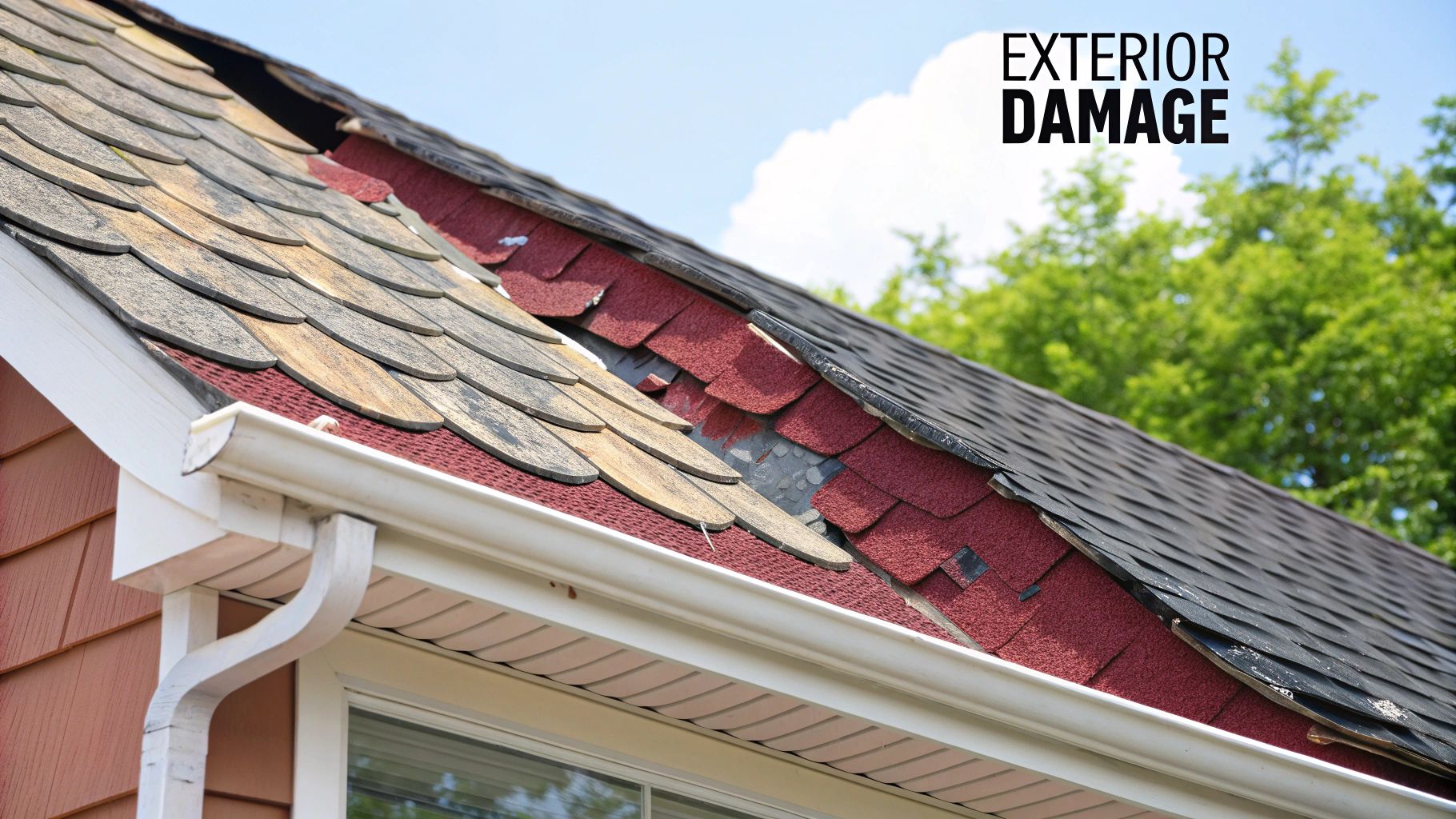
Your roof is constantly trying to tell you something about its condition. It often communicates through subtle hints that are easy to overlook. Ignoring these early warnings can result in significant repair costs later. Knowing how to spot the signs of a failing roof is essential to safeguarding both your home and your finances.
Deciphering The Whispers: Subtle Signs of Roof Trouble
Regular roof inspections are just as important as regular checkups with your doctor. They are key to identifying potential problems early on. While a leaky roof is an obvious sign of trouble, more subtle signs often appear first.
For instance, keep an eye out for curling or buckling shingles. This warping suggests the shingles are losing their protective granules and are nearing the end of their lifespan. Also, check your gutters for an accumulation of these granules.
A substantial amount of granules, resembling coarse sand, is another indicator of shingle deterioration. While seemingly insignificant, this issue can lead to leaks if not addressed. For more insights on winter roof damage, check out this helpful resource: How to identify early signs of winter roof damage.
Recognizing The Shouts: Obvious Signs of Roof Failure
Sometimes your roof sends a much louder message that it needs attention. Missing shingles are a clear example. A few missing shingles might seem like a minor issue, but they leave your roof vulnerable to the elements. This increases the risk of leaks and more extensive damage.
Sagging areas on your roof are a major warning sign. This indicates structural damage, possibly from rotting wood or weakened supports, and requires immediate professional assessment.
The lifespan of a roof is influenced by several factors, including weather conditions, maintenance, and the quality of materials used. Across the United States, approximately 7% of single-family homes receive new roofs each year. However, in hurricane-prone regions like Florida and the Gulf Coast, that number jumps to 20% annually, with the average roof lasting only 15-18 years before replacement. For a deeper dive into these statistics, visit: https://attotime.com/blog/roofing-industry-statistics.
Ignoring your roof's messages, whether subtle or blatant, can lead to substantial expenses in the future. Addressing these signs promptly allows you to make informed choices and potentially save money in the long run.
The Age Game: Why Your Roof's Birthday Matters
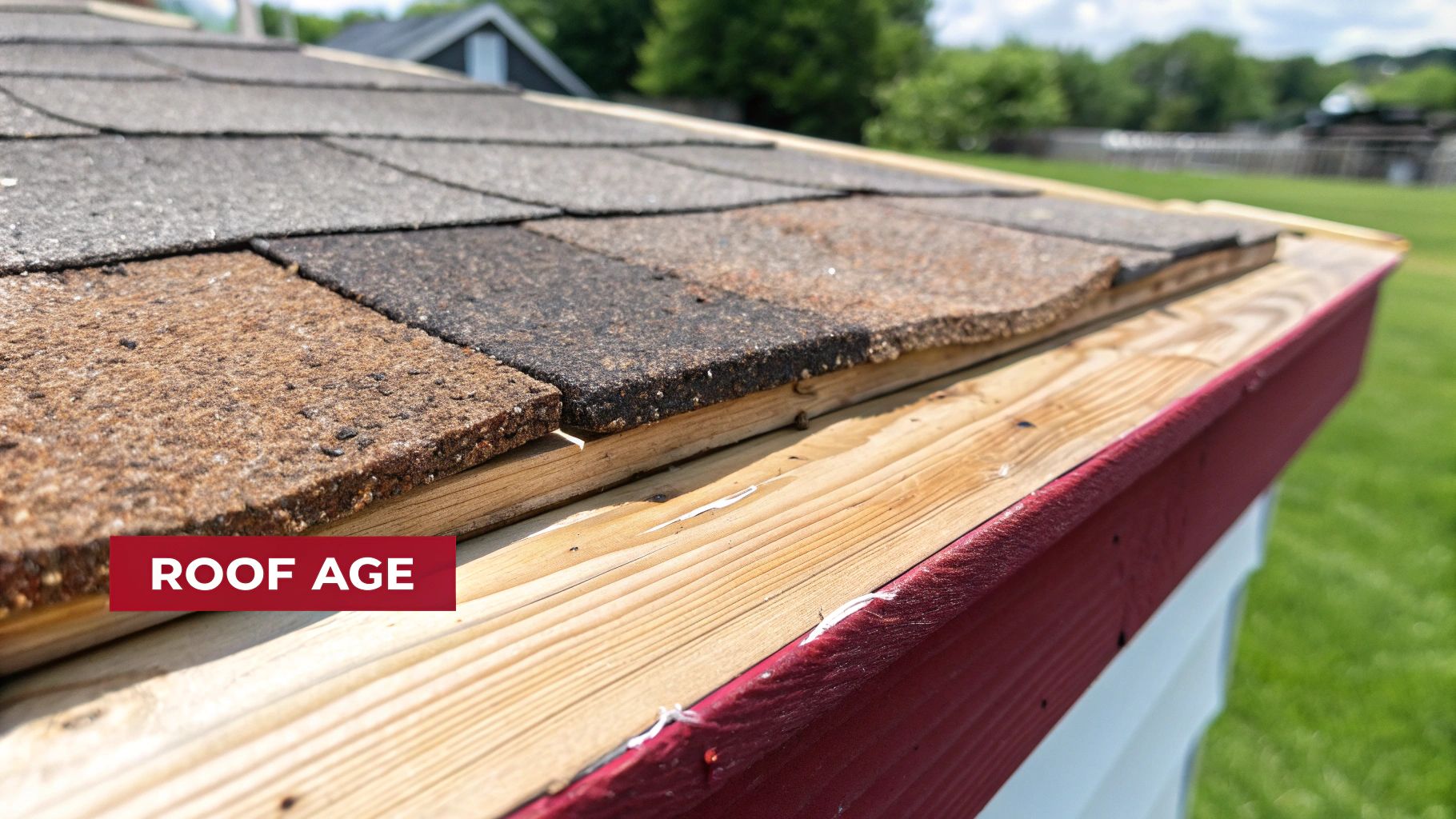
Just like us, roofs age over time. Knowing your roof's age is the first step in understanding when it might need replacing. While manufacturers often tout long lifespans, real-world conditions can tell a different story. Let's explore how to realistically assess your roof's age and what factors influence its lifespan.
Decoding Roofing Lifespans: Marketing vs. Reality
Those impressive lifespans advertised on roofing materials? They're often best-case scenarios. Real-world factors like weather, installation quality, and maintenance significantly impact how long a roof actually lasts. An asphalt shingle roof advertised to last 30 years might need replacement after only 15 due to harsh weather, for example.
Knowing the typical lifecycle of various roofing materials is crucial. In the U.S., around 5 million residential roofs are replaced annually, representing a $20 billion market. The typical lifespan for common asphalt shingles falls between 15 and 30 years, highlighting the importance of regular inspections. Find more detailed statistics here.
How Climate Impacts Your Roof's Longevity
Your local climate significantly impacts a roof's aging process. Just as sun exposure damages skin, constant exposure to harsh elements weathers a roof. Intense sun, heavy rain, strong winds, and temperature swings can all contribute to premature aging.
Frequent hailstorms, for instance, often necessitate more frequent roof replacements due to impact damage. Conversely, a well-maintained roof in a mild climate might outlast its expected lifespan. Considering your climate is key to accurate roof assessment.
Calculating Your Roof's Remaining Useful Life
Predicting a roof's lifespan precisely is difficult. However, you can estimate its remaining useful life by considering a few key factors:
-
Material: Different materials have varying lifespans. Asphalt shingles typically last 15-30 years, while tile can last 50+ years.
-
Age: Knowing your roof's installation date is crucial. This helps determine where it falls within its expected lifespan.
-
Condition: Visible signs of wear and tear, such as curling shingles, granule loss, or moss growth, indicate a declining lifespan.
-
Climate: Harsh climates shorten a roof's life expectancy. Factor in your local weather patterns.
By evaluating these factors, you can better estimate when a new roof might be needed and make informed decisions about maintenance and replacement. This proactive approach can help you avoid costly emergency repairs and protect your home.
Your DIY Roof Detective Toolkit
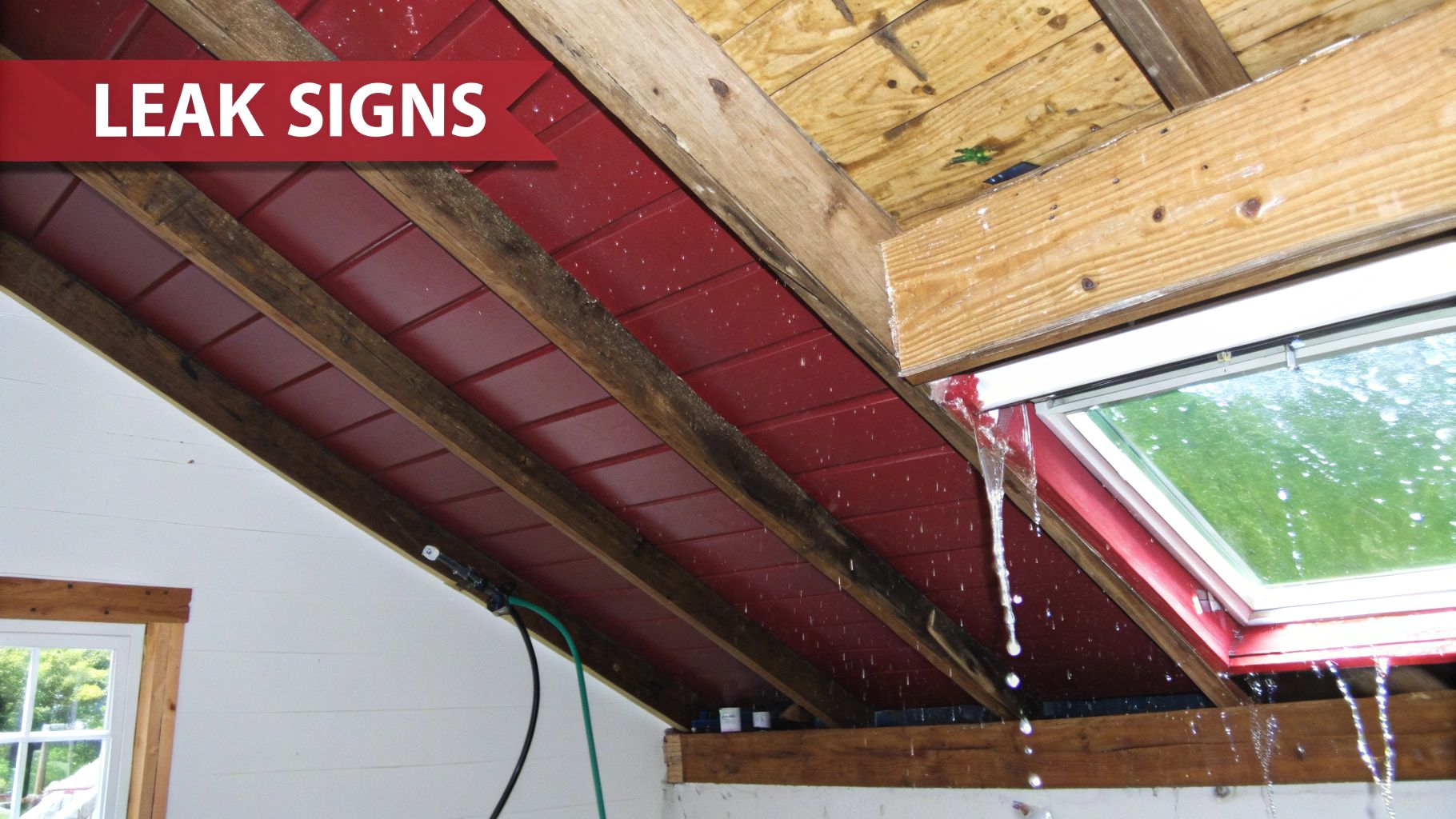
Worried about your roof's condition? You don't need to be a roofing professional to get a good idea of its health. This guide provides the tools and knowledge to conduct a basic roof assessment from the ground and your attic. This DIY approach, adapted from professional methods, will help you decide if it's time to call in the experts.
Ground-Level Observations: Spotting Trouble From Afar
Your detective work begins at ground level. Binoculars are invaluable tools, allowing you to spot details like curled, cracked, or missing shingles without climbing a ladder.
Also, check your gutters for excessive granule buildup. These granules, resembling coarse sand, protect your shingles from the elements. Finding them in your gutters is a telltale sign of shingle deterioration.
Catching these early signs of aging can save you money by preventing potential water damage.
Inside Job: Clues Hiding in Your Attic
Your attic offers a different perspective on your roof's health. With a flashlight, look for signs of water damage like water stains, discoloration, or damp insulation. These are strong indicators of a leaking roof.
Also, check for daylight peeking through the roof boards. Light penetration suggests gaps or holes needing immediate attention. This inside view reveals the hidden state of your roof, crucial for determining its overall condition.
Seasonal Checkups: Catching Problems Early
Regular roof inspections, especially in spring and fall, are essential for preventive maintenance. These checks can identify damage from winter storms or summer heat.
Addressing minor issues early prevents them from becoming major problems, saving you from costly emergency repairs. For example, checking for moss growth after a wet winter is crucial, as moss traps moisture and damages your roof.
Recognizing Warning Signs: What to Look For
Knowing the signs of roof damage makes all the difference in assessing your roof’s condition. The following table summarizes common warning signs, their severity level, and recommended action. It provides a clear comparison of interior and exterior indicators, helping you understand what to look for both inside and outside your home.
Roof Inspection Checklist: Interior vs. Exterior Warning Signs
| Location | Warning Signs | Severity Level | Action Required |
|---|---|---|---|
| Exterior | Curling, buckling, or missing shingles | Medium to High | Professional inspection/repair |
| Exterior | Granule buildup in gutters | Medium | Monitor, potential repair needed |
| Exterior | Sagging roof sections | High | Immediate professional inspection |
| Interior (Attic) | Water stains, discoloration, damp insulation | High | Immediate professional inspection |
| Interior (Attic) | Daylight through roof boards | High | Immediate professional repair |
This table highlights the importance of checking both your attic and the exterior of your roof. While granule buildup might warrant monitoring, more serious signs like sagging or water damage require immediate professional attention.
This DIY detective work gives you a starting point for understanding your roof’s condition. While these techniques offer a good initial assessment, a professional roof inspection is always recommended for a complete evaluation and to determine if you need a new roof. This combined approach ensures you have the best information to protect your home.
When Mother Nature Calls The Shots
Your roof's lifespan isn't just about the materials or the installation. The environment plays a huge role, impacting how quickly your roof ages and the types of damage it faces. Understanding these factors is key to knowing when you need a new roof.
Climate's Impact: More Than Just Wear And Tear
Different climates throw different challenges at your roof. Coastal areas expose roofs to constant salt spray and humidity, speeding up corrosion. Areas with lots of snow face the danger of ice dams, which can trap water and cause leaks. This means a roof in a tough climate might need replacing sooner than one in a milder area, even if they're made of the same material.
Extreme temperature swings also cause roofing materials to expand and contract. This leads to stress and cracks over time. Just like bending a metal wire repeatedly weakens it, this constant expansion and contraction weakens your roof.
Storm Damage: The Silent Threat
Severe weather can significantly shorten a roof's life. Hail can create damage that isn't always visible right away. Large hail causes obvious problems, but smaller hail can create tiny fractures that weaken shingles.
For instance, “Hail Alley” (including Colorado, Nebraska, and Wyoming) accounts for 25% of insurance-driven roof replacements due to weather. The average replacement age in this area is 12-15 years. These statistics are helpful for homeowners when evaluating their roof's condition. Find more detailed statistics here.
High winds can also rip shingles off or lift their edges, making them vulnerable. Heavy rain can overwhelm your gutters and lead to leaks and water damage. These issues often need a professional to assess the damage and figure out if you need repairs or a replacement.
Regional Variations In Roof Lifespan
Where you live significantly affects how long your roof will last. Some regions just have harsher weather than others. Coastal areas face moisture and salt air, while areas with big temperature changes see more material stress.
Understanding these regional variations helps you know if a new roof is needed. A roof in Arizona might last for decades under the sun, but a roof in the Northeast may need replacing sooner due to snow, ice, and temperature fluctuations. Considering these factors helps you make smart decisions about your roof's care and when it's time for a replacement.
The Real Cost Of Waiting (And Acting)
Replacing a roof is a major investment. It's natural to hesitate, given the expense. But delaying a necessary replacement can actually lead to higher costs in the long run. Understanding the full financial picture, including the cost of inaction, is key to making smart decisions about your roof. You might be interested in: Our guide on roof replacement.
The Price of Procrastination: Hidden Costs of Delaying Roof Replacement
A minor roof repair might seem economical at first. However, repeated repairs can quickly accumulate. It's like patching a tire repeatedly instead of replacing it. Eventually, the patch costs and blowout risk outweigh the price of a new tire. Similarly, delaying a needed roof replacement often results in more extensive damage, increasing the final replacement cost.
A damaged roof can also trigger other expensive problems. Water leaks, for instance, can damage insulation, drywall, and even structural components. This can necessitate costly mold remediation and structural repairs, dramatically increasing the overall cost compared to a timely roof replacement.
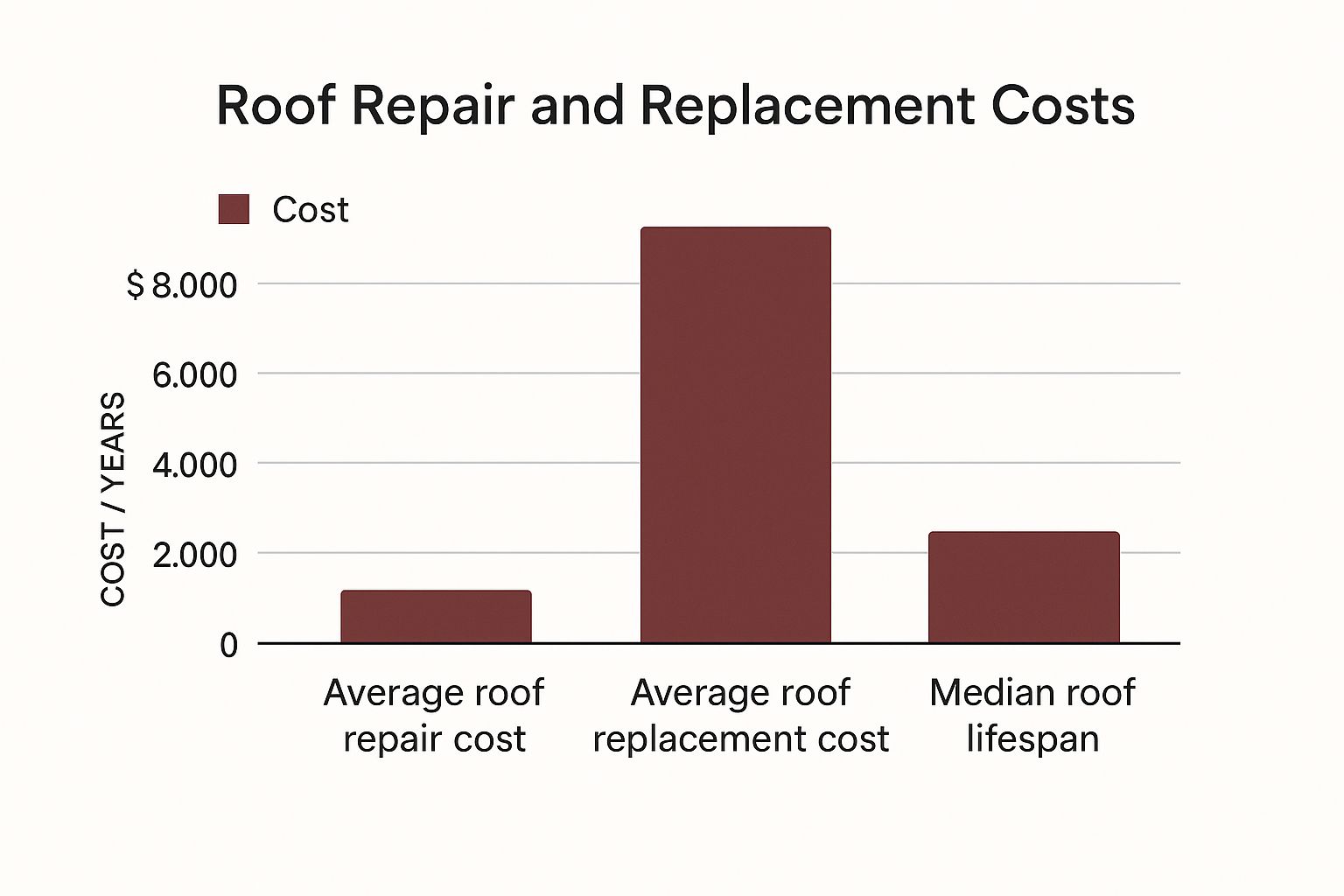
The infographic above illustrates the average costs of roof repair versus replacement, along with the median lifespan of a roof. A repair is much cheaper upfront. But a roof replacement, spread over its 20-year lifespan, can be more cost-effective than multiple repairs over the same period.
Investing in Protection: Long-Term Value of a New Roof
A new roof adds significant value to your home, both financially and in terms of peace of mind. It's attractive to potential buyers and protects against future damage. This investment offers immediate and long-term financial benefits.
Choosing quality materials might increase the initial cost, but it also extends the roof's lifespan and reduces future maintenance. This means better long-term value. For example, asphalt shingles are common and relatively affordable. However, tile roofs or metal roofs offer longer lifespans, potentially justifying their higher initial cost. Regular inspections are crucial for identifying wear and tear, such as missing shingles, leaks, or structural damage, which can signal the need for a new roof. The average cost of replacing an asphalt roof is around $10,053, highlighting the financial impact of delaying necessary replacements. Learn more about roofing industry statistics here.
To help illustrate the costs and lifespans of different roofing materials, let's take a look at the following table:
Roofing Material Cost Comparison And Lifespan Analysis
Detailed comparison of different roofing materials showing initial costs, expected lifespan, and long-term value
| Material Type | Average Cost | Expected Lifespan | Cost Per Year | Best For |
|---|---|---|---|---|
| Asphalt Shingles | $10,053 | 15-30 years | $335 – $670 | Budget-conscious homeowners |
| Tile Roofing | $30,000 – $50,000 | 50-100 years | $300 – $1,000 | Longevity and aesthetics |
| Metal Roofing | $15,000 – $35,000 | 40-70 years | $214 – $875 | Durability and energy efficiency |
As you can see, while asphalt shingles have the lowest upfront cost, tile and metal roofs offer significantly longer lifespans. This translates to a potentially lower cost per year over the life of the roof.
Balancing Budget and Protection: Making Informed Decisions
The decision to replace your roof involves balancing your budget with the long-term cost of waiting. Sometimes, delaying replacement is unavoidable due to financial constraints. However, understanding the potential costs of postponing this investment allows you to weigh the risks. This helps you make the best decision for your circumstances. A proactive approach, considering both current expenses and future savings, enables a well-informed decision about one of your home's most important assets.
Getting The Right Professional Opinion
Your own research is a great starting point, but a professional roof inspection is essential for a definitive assessment. Finding the right contractor is crucial. Look for professionals who prioritize honest evaluations over aggressive sales tactics.
What To Expect From A Quality Roof Inspection
A quality inspection report should clearly outline your roof's condition. It should detail existing damage, potential problems, and the expected lifespan of your current roof. Think of it like a doctor's diagnosis—identifying issues and recommending solutions, whether minor repairs or a full replacement. The report should also explain the reasoning behind these recommendations, empowering you to make informed decisions. Read also: Our roof inspection guide.
Asking The Right Questions: Separating Experts From Salespeople
Don't hesitate to ask contractors specific questions. Inquiring about their experience with different roofing materials, warranty terms, and their approach to repairs versus replacements helps you gauge their expertise. For example, asking about preferred ventilation methods reveals their understanding of proper roof installation. These conversations help distinguish experienced professionals from those focused on sales.
Additionally, inquire about licensing and insurance. A reputable contractor will readily provide this information, demonstrating their commitment to professional standards. This is similar to checking a doctor's credentials.
Navigating Multiple Opinions: When Contractors Disagree
Getting a second opinion is often worthwhile, especially for major investments like a new roof. Differing opinions can be confusing. If contractors disagree, review their inspection reports and ask clarifying questions. Understanding the reasons behind their assessments can help you make the best choice. This helps avoid costly mistakes and ensures your roof replacement delivers long-term value.
For instance, one contractor might recommend a full replacement due to shingle damage, while another suggests targeted repairs. Asking about the long-term costs and benefits of each approach provides a clearer understanding. This comparison allows for an informed decision based on your needs.
Red Flags and Second Opinions: Protecting Your Investment
Be wary of contractors who push for immediate replacement without a thorough inspection. High-pressure sales tactics are a red flag. The global roofing market provides perspective. In 2023, it was valued at roughly $82.2 billion, with a projected 5.5% compound annual growth rate, reflecting the worldwide need for housing and infrastructure development.
If something feels off, trust your instincts and seek a second opinion. A second inspection can provide valuable clarity, especially if you're unsure about a contractor's recommendations. Protecting your investment requires careful consideration and informed decisions.
Ready to ensure your roof protects your home? Contact Artisan Quality Roofing for a free inspection and estimate. We provide honest assessments and quality craftsmanship, serving Apex, Cary, Raleigh, and the surrounding Triangle area. Visit us at https://artisanqualityroofing.com to learn more.
Article created using Outrank



